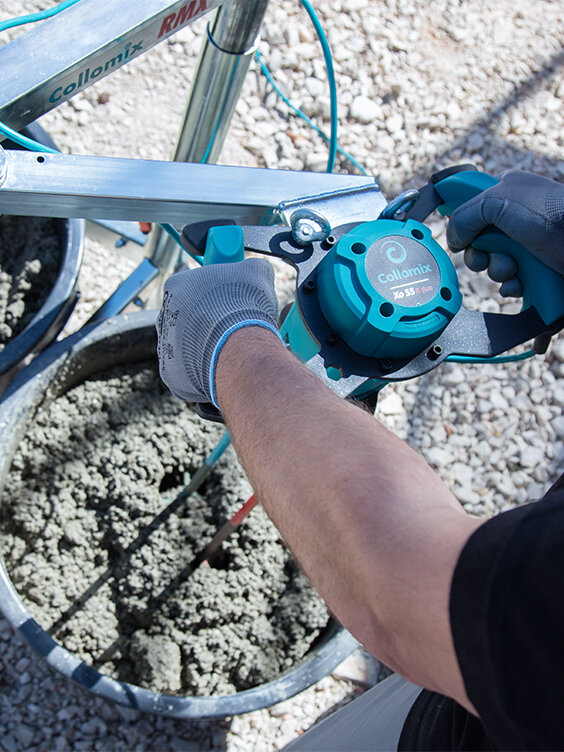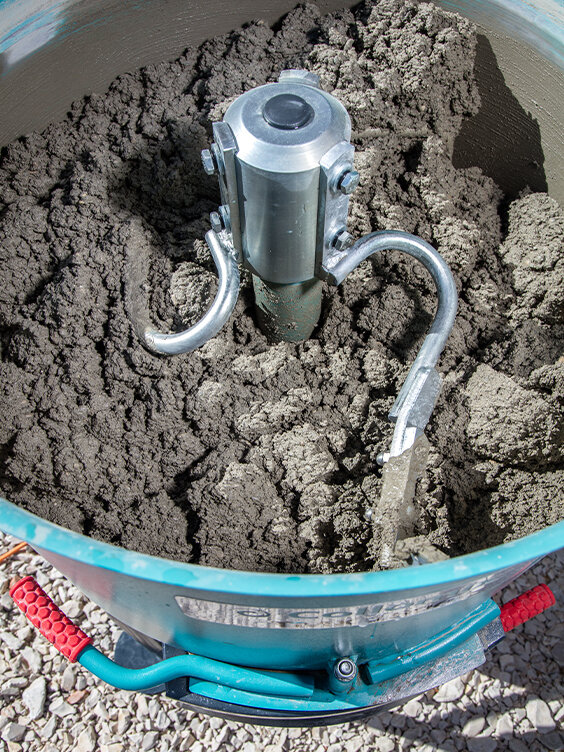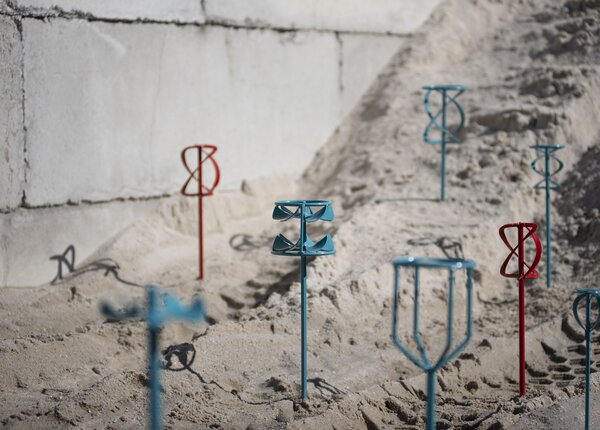
The Benefits of Mixing Properly
How to Mix and Pour Concrete in Extreme Weather
It's not unusual to have questions when you're getting ready to pour concrete about what kind of weather you should or should not be working in. Finding the right concrete setting temperature is ideal, but in many cases, construction doesn't take place when temperatures for concrete pouring are perfect. A concrete curing temperature chart will provide some direction in terms of the best possible temperatures to pour and cure concrete. When you are outside ideal temperatures and weather on a chart, there are ways to ensure that your concrete will come up to strength in the time and temperature you have available.

Pouring Concrete in Cold Weather
When you need to get work done in cold weather, you may wonder how much temperature can impact your ability to get the concrete to set up properly. Fortunately, the question of “can you pour concrete” in the winter was solved a long time ago, by using a range of additives that accelerate the setting process, hot water, and concrete blankets to keep your concrete from freezing before it sets up.
In this situation, it's important to quickly mix and place your concrete, so that it can take advantage of a warmed form and base. This can be achieved by running steam through an enclosure over the top of the form and can keep the concrete warm while it sets up. To achieve this fast mixing process, you'll want a mixing paddle that is capable of fast, powerful action to mix your warm ingredients so that they can be moved immediately into the form. For concrete, we recommend using our double-paddle mixer, the Xo 55 R duo.
A quick note: When talking about "concrete", it is always necessary to consider the quantity to be mixed. The Collomatic machines (TMX) play a very important role here. Only insignificant quantities are mixed with the hand mixer and paddle.
The American Concrete Institute defines cold-weather concrete work as when the curing time includes more than three days in a row with an average temperature below 40ºF and stays below 50ºF for more than half of any 24-hour period. When this happens, some of the special products mentioned above need to be used to ensure the concrete will cure to its estimated strength. For many situations, this means protecting the concrete from freezing for the first 24 hours or until it reaches 500 PSI in strength.
To make this happen, using hot water and keeping the aggregate in a warm location indoors can help for smaller batches. You can also increase the cement content or add calcium chloride by up to 2% to make the mix set up more quickly. You can also use heated blankets, heated enclosures, and windbreaks to prevent freezing. But what temperature is too cold to pour concrete? With appropriate protections, you could pour down to any temperature that you can still maintain the cure temperature for the concrete.
In these types of extreme cold conditions, many contractors will place Styrofoam or similar board insulation in the bottom of the pour, which also has the added benefit of preventing or limiting lifting and shifting due to freeze-thaw cycles. This is also a common practice in areas where digging down below the frost line is impractical, and has been used in regions of the United States where temperatures have reached as low as -60ºF.
Pouring Concrete in Hot Weather
However, that doesn't mean that pouring concrete in hot weather is easy either. There is a point where too high a temperature to pour concrete can also be problematic. In these situations, you'll want to make sure that you can get the concrete placed and finished before it sets up while still protecting it from excessive evaporation of water. This way, it can cure properly and reach its necessary strength. There are some additives you can place in your concrete mix to ensure that it will set more slowly, including fly ash and other retardants. Because it slows down the set time, it allows the concrete to cure slowly so that the full strength will develop over time.
If you can avoid pouring air entrained concrete, you can further lengthen your curing time, because there will be less air in the mix. Air entrained concrete has tiny bubbles of air that provide an insulating layer that prevents delamination and spalling. It is used for concrete that is exposed to significant freeze/thaw cycles but it also speeds up the curing process. To prevent unintentional air from being mixed into your concrete, we recommend Paddle MK, which mixes quickly and reduces the excessive mixing that may entrain air accidentally due to the time involved.
That being said, there can be a temperature to pour concrete that is too high to work successfully. In this case, it's because the concrete will often set up too quickly, preventing effective placement or quality finishing work. Interestingly enough, concrete cured at 100ºF will have a lower strength of 10-15% at 28 days due to rapid evaporation, because it has not been able to be properly worked and cured. By using a different set of additives, such as retardants or fly ash, and cold water, you can lengthen the time you'll have to work the concrete before it sets up.
Referencing American Concrete Institute standards, hot weather concrete is defined as concrete that is poured at temperatures above 100ºF, though this will vary somewhat depending on humidity. Concrete needs moisture to cure, so if the moisture evaporates off too quickly, some amount of strength will be lost. In these situations, mixing in small batches while using fly ash or retardants, cooling water and aggregate, and setting up shade, a mist system, or using damp blankets to keep the surface of the concrete damp will help it reach its expected strength.
In this situation, it can be tempting to add more water to your concrete mix, but this simply weakens the overall strength rather than creating a better environment for curing. In any situation, adding the proper amount of water to your mix can make the difference between success and failure, which is why precise measurement of the water you're adding is so important to the success of your project.

Pouring Concrete in the Rain
Can you pour concrete in the rain? It's a common question, especially given the issues that overly wet concrete can have with coming up to its full strength. For large pours, it's often recommended to wait until the rain passes if possible, but if there's no other option, make sure that you have tarps, plastic sheeting, or similar cover that you can move over the concrete as it's being finished to prevent damage by excessive moisture. If rain is a potential issue on the day that you're mixing and pouring concrete, scout out the site ahead of time and make sure that you know where water flow from gutters and downspouts may impact the project.
When rain is threatening, you want to make sure that you can quickly mix the batches you need so that you can get the concrete placed as quickly as possible. We recommend the Collomatic, which provides near-continuous small-batch mixing, allowing you to get the job done quickly when rain is threatening, making it a great option for crews where It's important to keep moving.
Though a hard rain or running water is bad for your concrete pour, allowing softer rainfall to land on the surface of the concrete can actually improve the curing process, especially if it's a light drizzle and you're expecting more dry weather soon. A completely dry surface on your concrete pour can actually cause significant issues with overall strength, delaminating, and spalling, which can require you to make extensive repairs and grind off the surface of the concrete for a thin top layer to be poured. If the surface has set, protect the concrete from driving rains, but allow softer rains to fall on the surface to improve the curing process. Damp blankets can be placed to retain moisture in warmer weather.
So what should you not do if it rains as you're laying concrete? First, don't incorporate rainwater on the surface of the concrete into the concrete. This can weaken the concrete dramatically and, as with the next no-go, can cause an issue called delamination, where the concrete cures in separate layers that can flake apart under weight or pressure. Second, don't spread dry cement over the surface of the water, which can ruin your finish and cure in a separate layer that can delaminate.
What should happen is after the rain has passed, use a float to push the water off of the surface of the concrete that has been placed. If the concrete had set at the surface before the rain, the extra moisture would actually help it cure. Once the concrete has dried off, a screwdriver, or scratch test kit can test the surface to check for damage. If there is damage, such as color that has run off, delamination, or dusting on the surface, grinding off a surface layer and placing a thinset overlay is often the best solution.
